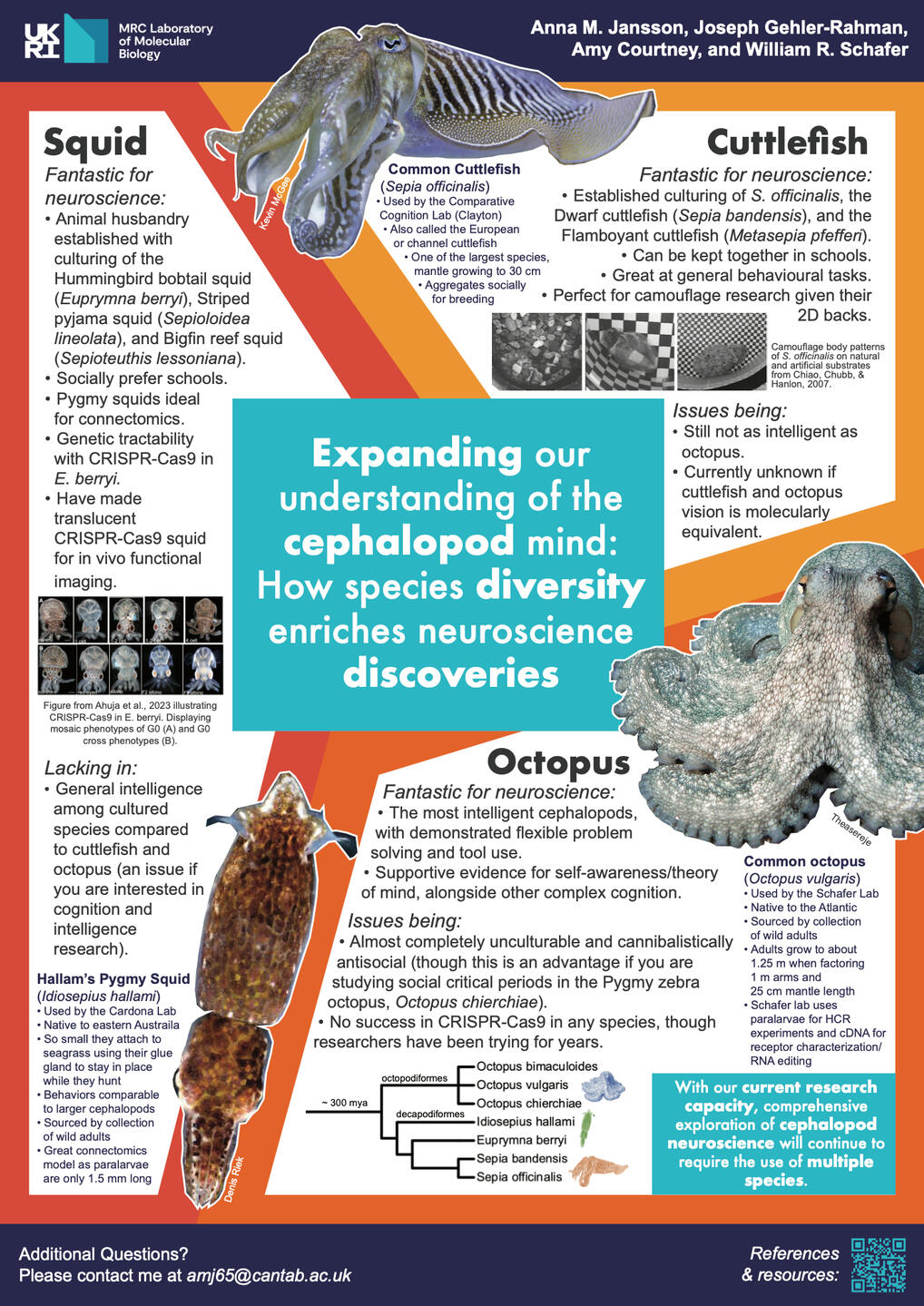
Anna M. Jansson
Sensory Neurobiologist
Molecular and cellular researcher with a particular interest in phototransduction and somatosensation. Passionate about the development of cephalopods (coleoids in particular; octopus, squid, and cuttlefish) and other funky critters as model organisms for basic neuroscience research.Beginning the Neuroscience Training PhD Program (NTP) at University of Wisconsin-Madison in Fall 2025. Recent Master's of Philosophy graduate from the University of Cambridge in Basic and Translational Neuroscience with a Bachelor's of Science from UW-Madison in Neurobiology and Chemistry (with a minor in Theatre).Other projects focusing on G-protein coupled receptors (GPCRs) in the Octopus vulgaris visual system, vesicle identification in Drosophila EM reconstructions (MRC Laboratory of Molecular Biology), and short-term synaptic plasticity of parvalbumin interneurons in mouse cortex (University of Wisconsin-Madison).
Expanding our understanding of the cephalopod mind:
How species diversity enriches neuroscience discoveries

Poster presentation and data blitz selection for the 35th annual Cambridge Neuroscience Seminar “CNS2025: Exploring the Horizons of Brain Research”.Selected for a special design prize.Abstract: Cambridge, cephalopods, and neuroscience have a longstanding connection, tracing
back to the use of the squid giant axon to develop the 1963 Nobel prize winning Hodgkin-Huxley model of the action potential. Entering the current global renaissance of cephalopod neuroscience, research groups in Cambridge continue to
utilise cephalopods as model organisms due to their capacity for intelligence and novel physiology. In particular, their body-centric nervous system, camera-type eyes, camouflage capabilities, and distinct evolutionary distance from mammals. Unlike the use of a standardised model species, cephalopod neuroscience research includes generalisations across a variety of species in order to support the exploration of more diverse questions. In Cambridge, this work is done with the pygmy squid (Idiosepius hallami, Cardona lab), the common octopus (Octopus vulgaris, Schafer lab), and the common cuttlefish (Sepia officinalis, Clayton lab). This local research includes connectomics, vision, RNA editing, and complex cognition, advantageously contributing to the global development of cephalopods as model organisms for neuroscience research, particularly in the broader context of evolutionary and comparative studies. Another component of this diverse species use results from difficulties in animal husbandry and technique adaptation, solidifying the need for species variety now and in the foreseeable future. Overall, the diverse species approach does seem efficient but does risk overgeneralisation between species. Standardisation of a cephalopod model could facilitate a deeper understanding of the unique evolutionary adaptations of a particular species or support faster biotechnology related discovery, but excluding any particular variety at this stage would severely limit the methodological capacity of the subfield.Themes: Neurons, Circuits and Networks, The Social Brain
Keywords: model organism, cephalopod, cognition, vision, connectomics, RNA editingInterest in CamCephs
Please add your details to this form if you are interested in being contacted about upcoming events to share research amongst the Cambridge cephalopod community. You do not need to be doing ceph research at this time to be included in the mailing list.References
Summary of current methods in cephalopod research
Baden T, Briseño J, Coffing G, Cohen-Bodénès S, Courtney A, Dickerson D, Dölen G, Fiorito G, Gestal C, Gustafson T, Heath-Heckman E, Hua Q, Imperadore P, Kimbara R, Król M, Lajbner Z, Lichilín N, Macchi F, McCoy MJ, Nishiguchi MK, Nyholm SV, Otjacques E, Pérez-Ferrer PA, Ponte G, Pungor JR, Rogers TF, Rosenthal JJC, Rouressol L, Rubas N, Sanchez G, Santos CP, Schultz DT, Seuntjens E, Songco-Casey JO, Stewart IE, Styfhals R, Tuanapaya S, Vijayan N, Weissenbacher A, Zifcakova L, Schulz G, Weertman W, Simakov O, Albertin CB. Cephalopod-omics: Emerging Fields and Technologies in Cephalopod Biology. Integr Comp Biol. 2023 Dec 29;63(6):1226-1239. doi: 10.1093/icb/icad087.Regarding relative cephalopod cognition (there are many more papers by Schnell and Clayton that one can also explore)
Schnell AK, Clayton NS. Cephalopod cognition. Curr Biol. 2019 Aug 5;29(15):R726-R732. doi: 10.1016/j.cub.2019.06.049.CRISPR-Cas9 for E. berryi albino squid line (including figure used here)
Ahuja N, Hwaun E, Pungor JR, Rafiq R, Nemes S, Sakmar T, Vogt MA, Grasse B, Diaz Quiroz J, Montague TG, Null RW, Dallis DN, Gavriouchkina D, Marletaz F, Abbo L, Rokhsar DS, Niell CM, Soltesz I, Albertin CB, Rosenthal JJC. Creation of an albino squid line by CRISPR-Cas9 and its application for in vivo functional imaging of neural activity. Curr Biol. 2023 Jul 10;33(13):2774-2783.e5. doi: 10.1016/j.cub.2023.05.066. Epub 2023 Jun 20.CRISPR-Cas9 in Doryteuthis pealeii (Longfin inshore squid)
Crawford K, Diaz Quiroz JF, Koenig KM, Ahuja N, Albertin CB, Rosenthal JJC. Highly Efficient Knockout of a Squid Pigmentation Gene. Curr Biol. 2020 Sep 7;30(17):3484-3490.e4. doi: 10.1016/j.cub.2020.06.099. Epub 2020 Jul 30.Pygmy squid use for comparative connectomics (more to come, Dr. Correia to publish on her thesis work)
Barsotti E, Correia A, Cardona A. Neural architectures in the light of comparative connectomics. Curr Opin Neurobiol. 2021 Dec;71:139-149. doi: 10.1016/j.conb.2021.10.006. Epub 2021 Nov 24.Fundamental work in cuttlefish camouflage (including figure used here)
Chiao CC, Chubb C, Hanlon RT. Interactive effects of size, contrast, intensity and configuration of background objects in evoking disruptive camouflage in cuttlefish. Vision Res. 2007 Jul;47(16):2223-35. doi: 10.1016/j.visres.2007.05.001. Epub 2007 Jun 25.Schafer Lab preprint on novel dopamine-gated cation channel and acetylcholine-gated anion channel in the Octopus visual system
Courtney A, Styfhals R, Van Dijck M, Boulanger J, Geenen L, Lanoizelet M, Hardege I, Lassnig M, Jansson AM, Gehler-Rahman J, Almansa E, Obenhaus HA, Seuntjens E, Schafer WR.
Novel dopaminergic neurotransmission in the Octopus visual system. bioRxiv. 2025.04.02.646353; doi: 10.1101/2025.04.02.646353.Cell type RNA-seq paper for Octopus vulgaris (others exisit for many species)
Styfhals R, Zolotarov G, Hulselmans G, Spanier KI, Poovathingal S, Elagoz AM, De Winter S, Deryckere A, Rajewsky N, Ponte G, Fiorito G, Aerts S, Seuntjens E. Cell type diversity in a developing octopus brain. Nat Commun. 2022 Nov 30;13(1):7392. doi: 10.1038/s41467-022-35198-1.Resources
Schafer Lab Website: https://www2.mrc-lmb.cam.ac.uk/groups/wschafer/Comparative Cognition Lab (Clayton) Website: https://www.psychol.cam.ac.uk/cclCardona Lab Website: https://syn.mrc-lmb.cam.ac.uk/Contact info for cuttlefish culture at the Marine Biological Association (UK): https://www.mba.ac.uk/our-facilities/research-aquarium/Marine Biological Laboratory (USA) cephalopod culturing information: https://www.mbl.edu/research/resources-research-facilities/marine-resources-center/cephalopods/cephalopod-breeding-center